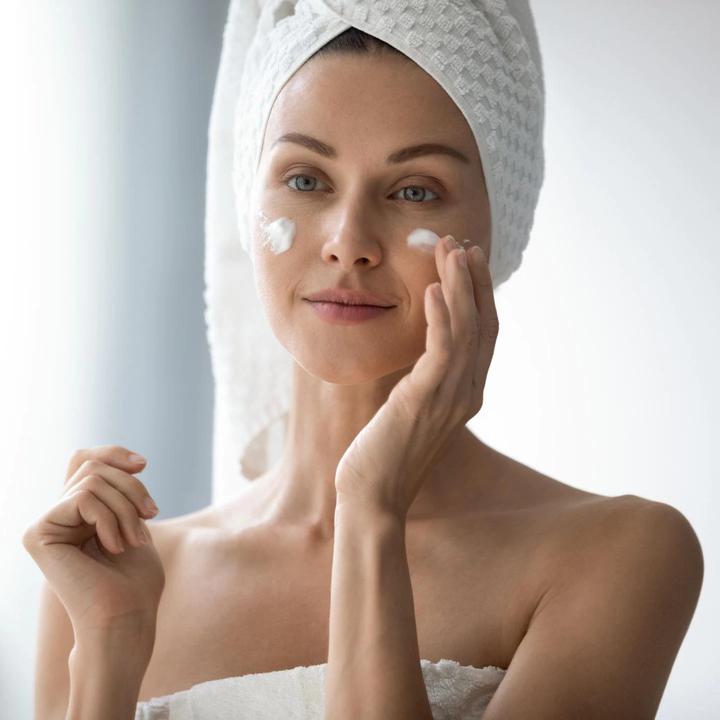
The fact that our skin turns brown is a protective mechanism of our body. Because as soon as it comes into contact with UV radiation, melanin production runs at full speed. This endogenous dye (skin dye) protects the skin by converting the rays into heat. Actually very clever!
However, this process in the skin can be disturbed by various factors. Then certain cells (melanocytes) either produce too much melanin, which leads to brown discoloration of the skin (hyperpigmentation). Because: The pigments are no longer distributed evenly, but clump together. However, it can also happen that too little or no melanin is formed in some areas. This so-called depigmentation manifests itself in white patches on the skin.
What external influences can cause pigment spots?
If pigment disorders are genetic and differ from skin type to skin type, such as freckles or skin diseases such as vitiligo, there is hardly anything you can do about it. However, many pigment spots only appear as a result of external influences or are intensified by them. These include hormonal changes, such as pregnancy or taking birth control pills, high and long exposure to the sun without SPF or photosensitizing drugs.
However, the main cause of pigment spots is strong UV exposure - which is why the discolouration also occurs primarily in areas that are particularly exposed to the sun, such as the face, décolleté, arms and hands. Since the skin as a whole has more and more to do with hormone fluctuations or UV light with increasing age, many people call the hyperpigmentation, i.e. the dark skin spots, also age spots (according to lipofuscin). These pigment spots appear on the hands in particular - we have anti-aging tricks for the hands and other anti-aging topics.
Pigment spots: are they dangerous?
In the case of hyperpigmentation, a distinction is made between melasma and pigment spots. The former are usually caused by hormonal changes and are ocher to light brown discolorations. They are mainly found on the face, upper lip area, forehead and cheekbones.
Pigment spots, on the other hand, not only appear on the face, but also on the décolleté, hands and arms. They are beige to dark brown, sharply demarcated in shape and usually only a few millimeters in diameter. They often occur as a result of increased UV radiation and are therefore often observed in light-skinned, older women. This is where the term age spots comes from. Not to be confused with liver spots (lat. lentigines). These are usually congenital or arise in young adulthood. Here we tell you everything you need to know about mole removal.
Are they a sign of skin cancer?
Melasmas, like pigment spots, are completely harmless from a medical point of view. Nevertheless, you should definitely have them checked as part of the annual skin screening. Because UV radiation also promotes skin cancer. Liver spots should also have an annual skin screening, as they can degenerate and become malignant. It is therefore very important for a doctor to regularly check and delimit liver spots, melasma and pigment spots. And: Always apply LSF 30-50!
How to prevent pigment spots:
Since hyperpigmentation is usually caused or promoted by exposure to the sun, a high SPF sun protection is the be-all and end-all, especially for sensitive skin. This applies especially during pregnancy or when ingesting the pill, as the skin is then usually more sensitive and delicate. You should be careful not to wait until you get older to start using sunscreen. It is optimal if you wear UV protection with anti-aging from a young age, which has been tested for skin compatibility. For example, a day cream with SPF makes sense, but also hand creams and body lotions. It is better to avoid the midday sun in summer or on vacation to prevent any skin diseases or skin cancer.
How can you get rid of pigment spots?
- Creams with a lightening effect: So-called brightening creams (e.g. 'Even Brighter' from Eucerin or La Roche-Posay with the 'Pigmentclar' series) help to lighten pigment spots and prevent pigmentation disorders. The active ingredients contained are able to break down and transport away melanin and to inhibit the production of the pigment.To counteract the pigmentation disorder, the creams must be used daily over a longer period of time so that the first results are visible.Whitening creams with vitamin C, Mulberry or oleic acid extract can also reduce the production of melanin.You can use care and correction sticks to conceal pigment spots in a targeted manner.
- Chemical peels: Chemical peels are used with the help of acids in such a way that the skin underneath becomes irritated and peels begins. A procedure that should definitely be evaluated and carried out by a specialist. Depending on the extent of the pigment disorders, several sessions may be necessary. Since the new skin after this treatment is very (light) sensitive, it is recommended that chemical peels only be carried out in the winter months. Impure skin also benefits from a chemical peel.
- Laser treatment: Discolorations can also be tackled with a laser. It precisely hits the cells that contain too much dye and dissolves them. The dye is then removed by your own immune system. This is to protect the surrounding tissue as much as possible. As with a chemical peeling, the laser treatment can only be carried out in the winter months in order not to additionally stress the light-sensitive skin. And: Always seek advice from an expert!
If you prefer to get rid of your pigment spots naturally, we have put together the best home remedies for pigment spots.
This is how pigment spots can be properly covered!
Pigment spots cannot usually be covered with a conventional foundation. Luckily, there are a few good tips and tricks you can use to hide pigmentation problems. 1 of 31 of 3
1. Concealer
Normal make-up usually does not completely cover noticeable skin changes such as pigment spots. If the shade is too light, the actually brownish spots show through greyish and make the complexion look sallow. If the make-up is too dark, it quickly looks unnatural. It is therefore best to first use a concealer in your own skin tone in order to paint over the darker spots. Basically, concealer is nothing more than a foundation - just more pigmented and therefore better covering. Then apply the foundation and blend the transitions well. Some companies have special cover sticks against pigment spots in their range. A special coloring neutralizes the brownish color of the pigment spot. Just like green concealer sticks are also used to conceal redness. Incidentally, such anti-pigmentation spot covering sticks also help with older, brownish scars or dark shadows under the eyes.More2 of 3
2. BB and CC creams
Not very pronounced pigment disorders can be concealed with BB or a slightly more heavily pigmented CC cream. These complexion beautifiers are not as opaque as make-up and therefore look more natural. In addition, many products have the added value that they contain lightening ingredients. In this way, the spots are covered and gradually lightened with regular application. Another advantage: Many creams are equipped with a sun protection factor. Since pigment spots are partly caused by the sun and can become even darker when exposed to radiation, a high sun protection factor is the alpha and omega of prevention.More 3 out of 3
3. Camouflage
Really dark pigment disorders can only be tackled with camouflage. These products are equipped with a particularly large number of color pigments and are therefore highly opaque. It is best to dab it onto the affected area and then fix the area with powder. Camouflage not only conceals very well, but also very reliably. Due to the high pigmentation, it is also waterproof. Camouflage not only withstands sweat during sports, but also when you go to the swimming pool.More







